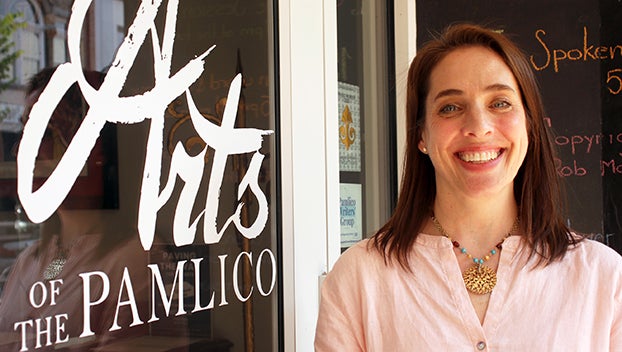PROBLEM SOLVER: Math, preservation behind the art of framing
Published 6:53 pm Monday, January 25, 2016

MEREDITH LOUGHLIN
FRAMED: Neil Loughlin, owner of Lone Leaf Gallery with his wife, Meredith, puts the final touches on a print brought to the shop for framing.
Neil Loughlin does math — a lot of it. As co-owner of Lone Leaf Gallery & Custom Framing with his wife, Meredith, his days are often immersed in measurements and cuts that must be precise the first time around.
“I do a lot of math — more math than I thought I’d ever do with an art degree,” Loughlin laughed.
For almost seven years, Loughlin has been taking in customers’ prized possessions and turning them into framed works of art. He has framed textiles and maps, canvas and photographs, portraits and watercolors. Each piece is unique and each piece is approached with one idea in mind: preservation.
“The most important thing is definitely preserving (a piece) and not damaging anything,” Loughlin said. “You have to be very careful and you need to be efficient with your materials because they’re expensive. You just want it to always hold up, forever.”
With that in mind, each piece is framed with acid-free materials to prevent what’s called “mat burn,” brownish marks caused by migration of acid from the mat onto whatever it’s framing. Loughlin also uses glass coated with a thin film that blocks nearly 100 percent of damaging UV rays and protects the piece from ambient light.
“That’s gotten more affordable now. We always use that on everything,” Loughlin said.
Preservation may be the priority in framing, but each work that comes through the door represents its own challenge, one that he tackles by working with the customer and through brainstorming sessions with Meredith.
“You want to find something that looks good with the piece, something they can enjoy. It’s got to fit their budget,” Loughlin said. “It’s almost like you have to find a good balance.”
Though most customers inherently know what works with their piece, given the time to wander around and look at the many framing options, Loughlin occasionally has to steer them in a more aesthetically workable direction.
“Some people want stuff that’s too heavy or sometimes they want a frame that’s not substantial enough,” Loughlin said. “(You have to remind them) they’re not framing for their home, but framing for that piece. Then they can move it around anywhere and it will always look good.”
“It’s definitely a collaboration with the customers,” Loughlin said. “It’s their piece; they need to find something they love.”
An example is a series of four, small cross-stitch horses brought to Lone Leaf for framing. Rather than take the less-challenging road of framing the four together in a single mat with oval cutouts, the Loughlins framed the four pieces, each displayed in a cross-stitch hoop, in a shallow shadow box.
Loughlin said being responsible for so many people’s treasured items has proven to be a rewarding part of the profession.
“The cool thing about framing is that your customers are your community,” Loughlin said. “It’s nice because you’re part of the community.”





